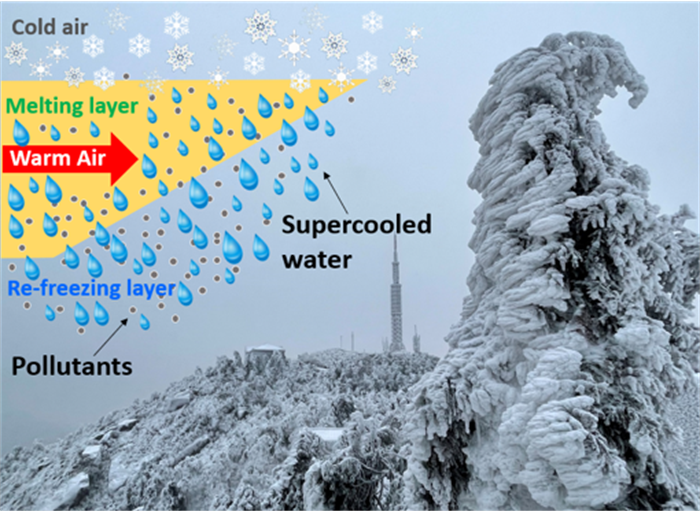Freezing rain is a typical weather disaster in winter and early spring over many regions of the world, even tropical areas. It exists as supercooled water (below 0 °C) in the air and freezes immediately after depositing on cold surfaces. In southern China, freezing rain mainly happens in the mountainous areas with harmful effects on electrical transmission infrastructure, transportation systems and the general public. In 2008, an extreme freezing rain and snowstorm swept across southern China and caused 129 fatalities and over 21 billion U.S. dollars of losses.
The nature of freezing rain is that raindrops stay supercooled in the atmosphere below 0 °C. Previous studies have attributed the presence of supercooled drops in the atmosphere to the lack of ice nuclei. In fact, this is not the case, because ice nuclei remain in supercooled drops when snow melts and forms these drops at even higher, and warmer, levels of the atmosphere. Laboratory experiments found that elevated soluble chemicals help the drops stay supercooled, and this chemical effect, known as freezing point depression, is also reproduced by numerical models. However, there is still no evidence from field observations that the effect of freezing point depression exists in the precipitation.
Since 2015, Drs. LI Xingyu and PAN Yuepeng from the Institute of Atmospheric Physics of Chinese Academy of Sciences have been conducting a long-term measurement of the physical and chemical composition of freezing rain at Mount Heng, which lies in southcentral China at 27°18′6″N 112°41′5″E. The elevation of the sampling site is 1265.9 m, above the top of the atmospheric boundary layer, with temperature near 0 °C in winter favoring the occurrence of supercooled fog and freezing rain. This sampling site has also recorded the record icing thickness in China. According to the first seven-year observations, the freezing rain at Mount Heng was found to be acidic (pH < 5) with higher concentrations of soluble ions and organics than those in rain.
Freezing at Mountain Heng (Photo credit: LI Xingyu)
They also work with climatologists at universities and research institutes in Canada and China to explore the formation mechanisms of freezing rain and their trends in future. They find as the concentrations of soluble ions (especially ammonium nitrate) increase, the ambient temperatures of freezing rain show decreasing trends. Their collaborative research is published in
Atmospheric Environment.
"This study presented the first chemical view on freezing rain, a physical phenomenon in traditional belief," says Prof. Ronald STEWART at the University of Manitoba of Canada, a coauthor of the study. "The higher ionic concentration may depress the temperature needed to freeze raindrops and this process prolongs the existence of freezing rain", continues STEWART.
"Against the background of global warming, the influencing area of the freezing rain will shift northward, and the effect of freezing point depression induced by air pollution in northern China may be amplified”, adds Dr. ZHU Xiaying at the National Climate Center, another coauthor of the study.
Reference: Xingyu Li, Yixuan Lü, Yuepeng Pan, Qian Sun, Xiaying Zhu, Jiabao Hu, Jin Liu, Jing Cao, Mengna Gu, Mengshen Zhang, Ronald E. Stewart. Chemical characteristics of freezing rain observed at Mount Heng in southern China. Atmospheric Environment. 2022. https://doi.org/10.1016/j.atmosenv.2022.119140
Media contact: Ms. LIN Zheng, jennylin@mail.iap.ac.cn

